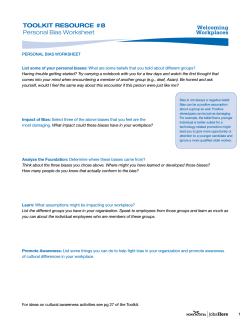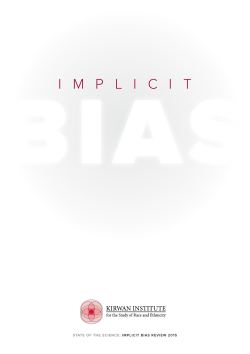
Intrinsic biases systematically affect visuomotor adaptation
Intrinsic biases systematically affect visuomotor adaptation experiments J. Ryan Morehead & Richard B. Ivry Department of Psychology, UC Berkeley Summary ivrylab.berkeley.edu ryanmorehead@berkeley.edu • Participants show systematic angular biases in center-out reaching without feedback • With feedback, these biases are attenuated, but persist in subtle ways. They quickly return when feedback is removed • Experiments assessing aftereffects in the absence of feedback should measure the intrinsic bias of each participant to provide appropriate baseline • Counterbalancing the sign of perturbations is an effective technique to assess adaptation, independent of bias A systematic bias Angular bias at 24 targets spaced in 15°intervals around 360°. The function is remarkably similar across participants. Angular bias at 8 targets spaced in 45° intervals around 360°. Different hands, same bias Mean bias (n=10), measured separately for right and left hands. This finding argues against a simple biomechanical explanation of the biases. Trajectories for left and right handed reaches. Like any proper bias, it returns Origin of the bias Ghilardi et al. 1995 Vidras et al. 1997 Ghilardi et al. initially characterized these systematic biases and that they can be partially eliminated via visuomotor adaptation. Interestingly, allowing participants to view the true position of the hand prior to the reach fully eliminated the biases. This indicates that the bias arises from an error in the sensed position of the hand. Time course of error reduction when feedback is turned on, followed by decay back to initial bias when feedback is turned off. Data is binned by 5 reaches. Vidras et al. replicated and extended Ghilardi et al. by explicitly measuring the sensed position of both hands, and subtracting this perceptual bias from endpoint errors made in reaching. This transformation provided a succinct account for the majority of reaching errors with either hand. Feedback may not eliminate the bias Angular error measured on the fourth reach with feedback for each target. Angular error measured on the 10th reach with feedback for each target. The bias was not eliminated despite the wider spacing of targets and increased number of FB reaches. Simulated behavior with parameters fit to individual participant data. The simulation shown here involved 20 trials/target. A small, yet systematic bias persists even when the model reaches a steady state. Simulated behavior of a state-space learner with an extreme learning rate of .8. Systematic errors will persist for targets near sign flips of the bias function because of generalization. Color code (as in left panel) showing bias dynamics across each trial bin for each target location. Generalization of decay function. After initially measuring bias for all locations, feedback was provided for reaches to all locations. During probe period, feedback remained on one location and not provided at other locations. Decay was slower to return to the intrinsic baseline for targets without feedback (compare to above). Counter-balancing perturbations will control for the bias The effectiveness of this technique is demonstrated with two simulated learners who have the same intrinsic bias. We simulated perturbations of the same magnitude, but with opposite sign for the two learners. Top panel shows simulated behavior, showing composite effect of learning and bias. Flipping the sign of the behavior for one learner and then averaging the two functions eliminates the bias from the “group” results.
© Copyright 2025












